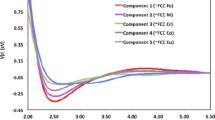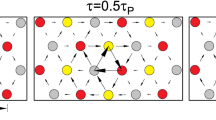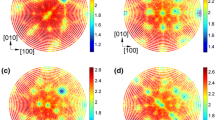Abstract
Based on the embedded atom method (EAM) proposed by Daw and Baskes and Johnson's model, this paper constructs a new N-body potential for bcc crystal Mo. The procedure of constructing the new N-body potential can be applied to other metals. The dislocation emission from a crack tip has been simulated successfully using molecular dynamics method, the result is in good agreement with the elastic solution.
Similar content being viewed by others
References
Berndt R, Gaisch R, Schneider WD. Atomic resolution in photon emission induced by scanning tunneling microscope.Physical Review Letter, 1995, 74(1): 102–105
Wang GJ, Sutton AP, Vitek V. A computer simulation study of [001] and [111] tilt boundaries: The multiplicity of structure.Acta Metall, 1984, 32(7): 1093–1104
Decelis B, Argon AS, Yip S. Molecular dynamics simulation of crack tip processes in alpha-iron and copper.J Appl Phys, 1983, 54(9): 4864–4878
Kitagawa H, Naktani A, Shibutani Y. Molecular dynamics study of crack initiation. In: Tokuda M, Xu B, Senoo M. Proceedings of IMMM'93 International Seminar Microstructures and Mechanical Properties of New Engineering Materials, Edited Mie University, Japan. Mie Academic Press, 1993. 19–26
Zhou FX, Peng BY, Wu XJ. Molecular dynamics study of deformation and fracture for pure and bismuth-segregated tilt copper bicrystals.J Appl Phys, 1990, 68(2): 548–555
Zhang YW, Wang TC, Tang QH. Brittle and ductile fracture at the atomistic crack tip in copper crystals.Script Metall Mater, 1995, 33(2): 267–274
Daw MS, Baskes MI. Embedded-atom method: derivation and application to impurities, surface, and other defects in metals.Phys Rev B, 1984, 29(12): 6443–6453
Johnson RA. Analytic nearest-neighbor model for fcc metals.Phys Rev B, 1988, 37(8): 3924–3931
Johnson RA, Oh DJ. Analytic embedded atom method model for bcc metals.J Mater Res, 1989, 4(5): 1195–1201
Rose JH, Smith JR, Guinea F, Ferrante J. Universal features of the equation of state metals.Phys Rev B, 1984, 29(6): 2963–2969
Beltz GE, Rice JR. In: Lowe TC, Rollett AD, Follansbee PS, Daehn GS, eds. Modeling the Deformation of Crystalline Solids. The Minerals, Metals and Materials Society, 1991, 457–467
Kurishita H, Oishi A, Kubo H, Yoshinaga H. Grain boundary in molybdenum bicrystals with various [110] symmetric tilt boundaries.Trans Japan Inst Metals, 1985, 26(5): 341–352
Alber I, Bassani JL, et al. Grain boundaries as heterogeneous systems: atomic and continuum elastic properties.Phil Trans R Soc Lond A, 1992, 339: 555–586
Zhang YW, Wang TC, Tang QH. Molecular dynamics simulation of crack-tip processes in copper.Acta Mechanica Sinica, 1995, 11(1): 76–82
Ohr SM. Dislocation-crack interaction.J Phys Chem Solids, 1987, 48(11): 1007–1014
Author information
Authors and Affiliations
Additional information
The project supported by the National Science Foundation of China
Rights and permissions
About this article
Cite this article
Qiheng, T., Tzuchiang, W. & Yongwei, Z. A new N-body potential and its application. Acta Mech Sinica 12, 358–367 (1996). https://doi.org/10.1007/BF02487801
Received:
Revised:
Issue Date:
DOI: https://doi.org/10.1007/BF02487801




